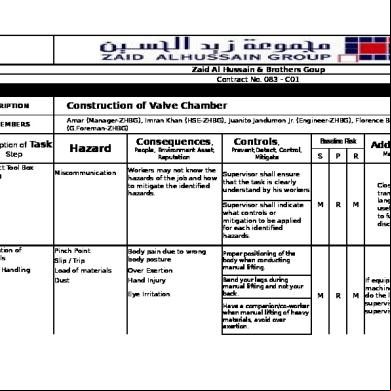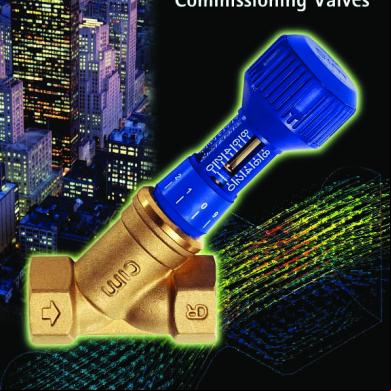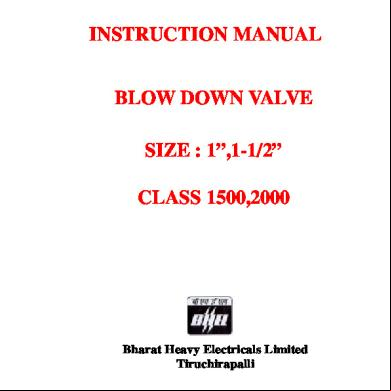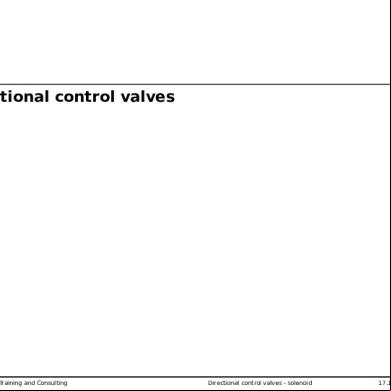[aseptomag] Double Chamber Valve - Type Dk 5s3w5j
This document was ed by and they confirmed that they have the permission to share it. If you are author or own the copyright of this book, please report to us by using this report form. Report 3b7i
Overview 3e4r5l
& View [aseptomag] Double Chamber Valve - Type Dk as PDF for free.
More details w3441
- Words: 1,026
- Pages: 3
Double-chamber Valve DK / DKBS / DDK / AXV
Aseptic double-chamber valve DK/DKBS Aseptic double-chamber valve DDK/AXV Functionality Aseptic double-chamber valves are flow control devices for aseptic processing plants. The integrated steam barrier (ISB) guarantees the safe separation of both product lines via the two seat seals. According to the complexity of the plant, the valve can be designed with one (DK), two (DDK) or three (AXV) sterile steam barriers.
- The leakage valve of the sterile chamber has a stroke of 25 mm so that lumpy products may be flushed out - The compact construction permits valve combinations with small dimensions - A PT-100 temperature probe can be integrated into the double-chamber valve through the leakage valve for monitoring purposes
The integrated function of the single-seat lifting capability permits fully automatic seat cleaning during production. The number of seals and moving parts are reduced to a minimum to provide easy maintenance and low Total Cost of Ownership. The valve guarantees the total separation of antagonistic media and offers you maximum process safety.
Design Characteristics - Modular design, consisting of the three main components: housing, internal assembly, and actuator - The actuator and internal assembly are connected to the housing with a three-piece clamp - Low-maintenance, service-friendly, and hygienic design - All product surfaces are made of AISI 316L stainless steel (materials certificate available upon request) with a surface finish of 0.8 μm Ra that meets all common hygienic standards - Complete actuator made of stainless steel - Customer-specific materials and surface finishes available upon request - Valve connections can be provided with aseptic flanges, screw connections, or clamps - Steam valve normally open by default, condensate valve normally closed. Alternate configurations are available.
Use - Valves are designed for use in the food, dairy and beverage, pharmaceutical, chemical, and cosmetics industries - The modular valve design allows integration into diverse process applications - Operating temperatures up to +150°C (+302°F), optionally increased up to +240°C (+464°F) - CIP (Cleaning-In-Place) and SIP (Sterilizing-In-Place) capable, up to +160°C (+320°F) - The intermediate chamber can be cleaned with condensate - The steam and leakage valves which form the steam barrier are fully integrated into the valve body and thus enable sealing without dead spaces
Valve Housing The housing is available as a standard or bottomseat variant with either two, three, or four port connections. The valves are produced with standard butt-weld connections by default. Bottom-seat valve housings are available with welded flange or screwed flange connection options.
Aseptic double-chamber valve type AXV with three sterile barriers
E/E E/T T/E T/T
Aseptic double-chamber valve type DDK with two sterile barriers
Aseptic double-chamber valve with sterile barrier
DK
Aseptic double-chamber bottom-seat valve
12
Functionality of the Double-Chamber Valve DK
Basic position Safe separation of media through applied steam/ condensate barrier.
Sterilization / flushing of the leakage chamber The steam is conducted away through the leakage valve.
Production The product runs through the valve.
Production below – CIP above Production (below) is secured by an active steam barrier towards cleaning (above).
CIP / cleaning of valve seat "A" During CIP the bottom seat is actuated to allow cleaning of the valve seat. Flushing occurs via the leakage valve. Upper seat remains sealed.
Internal Assembly The internal assembly is available with a shrunk-on or screwed-on valve seat seal. In addition to the standard sealant Tefasep®, other sealing materials such as PTFE, EPDM, Viton, etc., are also available. The nominal diameter of the valve is determined by the larger valve seat (upper seat seal “B” above). Actuator The standard version of the pneumatic actuator is designed as spring-closing / air-opening (NC). Available actuator options include: a drive without single-seat lifting (1 valve stroke), one with the seat-lifting of the bottom valve seat (seat A) and full stroke (2 valve strokes), and finally one with singleseat lifting of both valve seats (seats A+B) and valve full stroke (3 valve strokes).
CIP / cleaning of valve seat "B" During CIP the upper seat is actuated to allow cleaning of the valve seat. Flushing occurs via the leakage valve. Lower seat remains sealed.
Product CIP Steam Condensate
The functionality of the double-chamber bottom-seat valve DKBS is identical with that of the double-chamber valve DK.
Functionality
13
Dimensions of the pipe connections (acc. to DIN 11866) DN 25 40 50 65 80 100 125 150 DIN 11866 A (DIN 11850) Dim. Ø x s (mm) 29x1.5 41x1.5 53x1.5 70x2 85x2 104x2 129x2 154x2 DIN 11866 B (ISO) Dim. Ø x s (mm) 33.7x2 48.3x2 60.3x2 76.1x2 88.9x2.3 114.3x2.3 139.7x2.6 168.3x2.6 1½“
2“
2½“
3“
4“
25.4x1.65 38.1x1.65 50.8x1.65 63.5x1.65 76.2x1.65 101.6x2.11 1.0x0.065 1.5x0.065 2.0x0.065 2.5x0.065 3.0x0.065 4.0x0.083
6“ 152.4x2.77 6.0x0.11
D
1“
D
DIN 11866 C (OD) Dim. Ø x s (mm) Dim. Ø x s (inch)
D
125
150
D1 L1 L2 L3 L4 L5 L6
192 523.5 700 131 135 101 555
220 565 820 145.5 135 101 555
267 828 1120 189 190 131 615
92 349.5 490 74.5 60 52.5 355
112 503.5 670 90 95 67 487
112 519 750 96 90 67 487
150 489.5 640 105 90 74 501
192 522.5 700 121.5 100 90 533
D1
L1 L2
100
D
L4
L4
L3
Dimensions of the aseptic double-chamber valve DK DN 25 40 50 65 80
D
Other nominal diameters available upon request L5
L5 L6
Dimensions of the aseptic double-chamber bottom-seat valve DKBS DN 25 40 50 65 80 100 125* 92 140 356.5 486 103.4 60 52.5 355
112 185 521 660 135.5 90 67 487
112 185 536.5 680 145 90 67 487
150 185 504 640 135 100 74 501
192 220 541 740 160 100 90 533
192 250 546.5 800 165.3 135 101 555
340 267 821 1195 223.5 240 145.5 664
L3
D1 D2 L1 L2 L3 L4 L5 L6
L6 D2 L5 L5
L4
L4
L2 L1
Dimensioning
14
Other nominal diameters and bottom-seat versions available upon request * Standard execution BSO (screwed-on flange) D1
For a better overview, the top spouts in both images were turned by 45° and thus does not show the standard configuration of a cross valve.
Aseptic double-chamber valve DK/DKBS Aseptic double-chamber valve DDK/AXV Functionality Aseptic double-chamber valves are flow control devices for aseptic processing plants. The integrated steam barrier (ISB) guarantees the safe separation of both product lines via the two seat seals. According to the complexity of the plant, the valve can be designed with one (DK), two (DDK) or three (AXV) sterile steam barriers.
- The leakage valve of the sterile chamber has a stroke of 25 mm so that lumpy products may be flushed out - The compact construction permits valve combinations with small dimensions - A PT-100 temperature probe can be integrated into the double-chamber valve through the leakage valve for monitoring purposes
The integrated function of the single-seat lifting capability permits fully automatic seat cleaning during production. The number of seals and moving parts are reduced to a minimum to provide easy maintenance and low Total Cost of Ownership. The valve guarantees the total separation of antagonistic media and offers you maximum process safety.
Design Characteristics - Modular design, consisting of the three main components: housing, internal assembly, and actuator - The actuator and internal assembly are connected to the housing with a three-piece clamp - Low-maintenance, service-friendly, and hygienic design - All product surfaces are made of AISI 316L stainless steel (materials certificate available upon request) with a surface finish of 0.8 μm Ra that meets all common hygienic standards - Complete actuator made of stainless steel - Customer-specific materials and surface finishes available upon request - Valve connections can be provided with aseptic flanges, screw connections, or clamps - Steam valve normally open by default, condensate valve normally closed. Alternate configurations are available.
Use - Valves are designed for use in the food, dairy and beverage, pharmaceutical, chemical, and cosmetics industries - The modular valve design allows integration into diverse process applications - Operating temperatures up to +150°C (+302°F), optionally increased up to +240°C (+464°F) - CIP (Cleaning-In-Place) and SIP (Sterilizing-In-Place) capable, up to +160°C (+320°F) - The intermediate chamber can be cleaned with condensate - The steam and leakage valves which form the steam barrier are fully integrated into the valve body and thus enable sealing without dead spaces
Valve Housing The housing is available as a standard or bottomseat variant with either two, three, or four port connections. The valves are produced with standard butt-weld connections by default. Bottom-seat valve housings are available with welded flange or screwed flange connection options.
Aseptic double-chamber valve type AXV with three sterile barriers
E/E E/T T/E T/T
Aseptic double-chamber valve type DDK with two sterile barriers
Aseptic double-chamber valve with sterile barrier
DK
Aseptic double-chamber bottom-seat valve
12
Functionality of the Double-Chamber Valve DK
Basic position Safe separation of media through applied steam/ condensate barrier.
Sterilization / flushing of the leakage chamber The steam is conducted away through the leakage valve.
Production The product runs through the valve.
Production below – CIP above Production (below) is secured by an active steam barrier towards cleaning (above).
CIP / cleaning of valve seat "A" During CIP the bottom seat is actuated to allow cleaning of the valve seat. Flushing occurs via the leakage valve. Upper seat remains sealed.
Internal Assembly The internal assembly is available with a shrunk-on or screwed-on valve seat seal. In addition to the standard sealant Tefasep®, other sealing materials such as PTFE, EPDM, Viton, etc., are also available. The nominal diameter of the valve is determined by the larger valve seat (upper seat seal “B” above). Actuator The standard version of the pneumatic actuator is designed as spring-closing / air-opening (NC). Available actuator options include: a drive without single-seat lifting (1 valve stroke), one with the seat-lifting of the bottom valve seat (seat A) and full stroke (2 valve strokes), and finally one with singleseat lifting of both valve seats (seats A+B) and valve full stroke (3 valve strokes).
CIP / cleaning of valve seat "B" During CIP the upper seat is actuated to allow cleaning of the valve seat. Flushing occurs via the leakage valve. Lower seat remains sealed.
Product CIP Steam Condensate
The functionality of the double-chamber bottom-seat valve DKBS is identical with that of the double-chamber valve DK.
Functionality
13
Dimensions of the pipe connections (acc. to DIN 11866) DN 25 40 50 65 80 100 125 150 DIN 11866 A (DIN 11850) Dim. Ø x s (mm) 29x1.5 41x1.5 53x1.5 70x2 85x2 104x2 129x2 154x2 DIN 11866 B (ISO) Dim. Ø x s (mm) 33.7x2 48.3x2 60.3x2 76.1x2 88.9x2.3 114.3x2.3 139.7x2.6 168.3x2.6 1½“
2“
2½“
3“
4“
25.4x1.65 38.1x1.65 50.8x1.65 63.5x1.65 76.2x1.65 101.6x2.11 1.0x0.065 1.5x0.065 2.0x0.065 2.5x0.065 3.0x0.065 4.0x0.083
6“ 152.4x2.77 6.0x0.11
D
1“
D
DIN 11866 C (OD) Dim. Ø x s (mm) Dim. Ø x s (inch)
D
125
150
D1 L1 L2 L3 L4 L5 L6
192 523.5 700 131 135 101 555
220 565 820 145.5 135 101 555
267 828 1120 189 190 131 615
92 349.5 490 74.5 60 52.5 355
112 503.5 670 90 95 67 487
112 519 750 96 90 67 487
150 489.5 640 105 90 74 501
192 522.5 700 121.5 100 90 533
D1
L1 L2
100
D
L4
L4
L3
Dimensions of the aseptic double-chamber valve DK DN 25 40 50 65 80
D
Other nominal diameters available upon request L5
L5 L6
Dimensions of the aseptic double-chamber bottom-seat valve DKBS DN 25 40 50 65 80 100 125* 92 140 356.5 486 103.4 60 52.5 355
112 185 521 660 135.5 90 67 487
112 185 536.5 680 145 90 67 487
150 185 504 640 135 100 74 501
192 220 541 740 160 100 90 533
192 250 546.5 800 165.3 135 101 555
340 267 821 1195 223.5 240 145.5 664
L3
D1 D2 L1 L2 L3 L4 L5 L6
L6 D2 L5 L5
L4
L4
L2 L1
Dimensioning
14
Other nominal diameters and bottom-seat versions available upon request * Standard execution BSO (screwed-on flange) D1
For a better overview, the top spouts in both images were turned by 45° and thus does not show the standard configuration of a cross valve.





